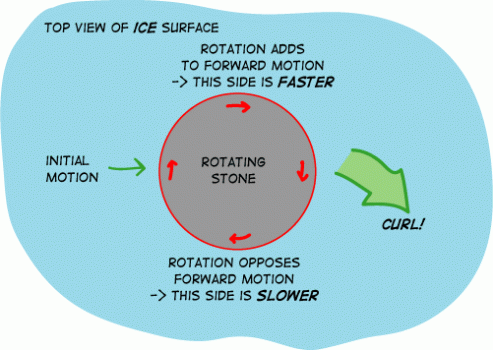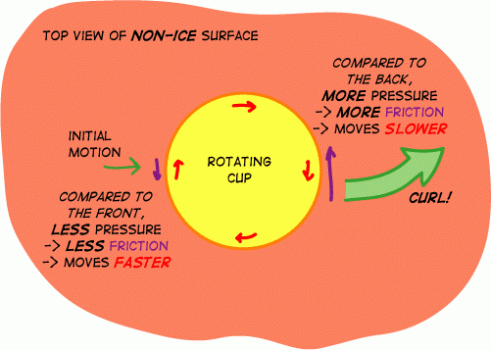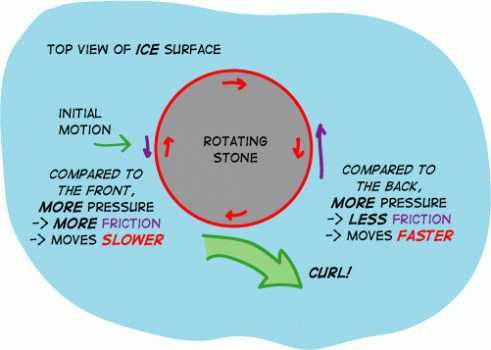Curling challenges the skills and strategies of both players who play it and scientists who study it. The game gets its name from the way curlers add spin to a curling rock so it will curl around other rocks. The curling happens just at the end, when the rock is slowing down.
The Rock
Also called a stone. The curling rock weighs between 16 and 20 kilograms. This is a video about how it's made from special quartz-free granite found only in Scotland and Wales. The bottom of a curling stone is not flat. It is more like a donut, with a ring upon which it contacts the ice. This reduces the surface area in contact, but increases the weight per unit area. On ice, this pressure raises the temperature of the ice and lowers its frictional coefficient, making it slipperier.
The Ice
Sweeping allows the rock to travel further without curling. A recent study using infrared cameras has found that the sweeping action raises the temperature. It doesn't melt it as some had speculated. Again, raising the ice temperature of the ice lowers its frictional coefficient, so the rock will slide further. I guess in the old days, before the rubbing technique, the brooms helped clean the surface to reduce the friction.
Left-Right Hypotheses
One explanation for the curl is that as a rock moves forward and rotates, the side where the rotational motion is in the same direction as the overall motion of the rock will move faster than the other side. When the forward motion slows, this difference becomes significant.
Long-time Flying Circus of Physics guru, Jearl Walker, explained this in a radio interview on the long-time science program Quirks and Quarks, with long-time Canadian science writer Jay Ingram, who wrote a nice chapter on curling science in his Velocity of Honey book.
Mark Denny, a physicist/science writer in BC, has also argued for a left-right difference in ice accumulation, because of a snow plow effect in which bits of ice tend to accumulate on the one side and result in more friction on the slower side as a result. Not to be confused with a rolling stone, which gathers no moss.
The Front-Back Hypothesis
The Ontario Science Centre has a video with a spiel about how an a round object like a drinking glass upside down on a surface, it will curl opposite to a curling rock. The explanation is that as it slows down, the front edge pushes down more and so you get more friction at the front edge (like when you put on the brakes and move forward in a car). The object moves in the direction of the back edge. Try this yourself at home, but I take no responsibility for any broken glass.
Frictional Character
A physics prof at the University of Northern British Columbia, Mark Shegelski says when these forces occur on a curling rock, the increased downward force in the front melts the ice, so it experiences less friction, not more. As a result, the rock moves in the direction of the front edge. As well, a proposed micro-layer of water would get carried around under the ring of the rock and add to the curl.
Final End
We seem to be stuck between a rock and a not-so-hard place. My money would go with the left-right approach, but I'd like to see more evidence to refute one or more of the explanations of how curling rocks curl. Of course, that's easier said than done. If any of you have done some experiments or have other curling insights on this situation, please add them to the comments.
In the meantime, go Canada go!